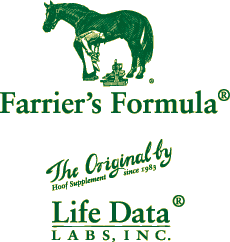Shoe Examples
|
One of the three tests given to farrier to become certified by the American Farriers Association includes being able to make shoes for special purposes. The shoes that I turned in for this portion of my testing are in the photo below. In case you are wondering, these shoes had to fit a pattern hind foot and pattern front foot that were given to me by the AFA. A farrier seeking certification can't just turn in shoes that demonstrate the shoe modifications alone. They must not only be able to make them but also make them fit a particular foot and know when to use them. These are just a few of the many shoes that I make for horses, but these are a baseline requirement for becoming a certified farrier by the AFA. There are other shoes highlighted on this website that I've built to address specific challenges that are not addressed with the shoes below. I do not limit my practice to the shoeing solutions shown below. |
|
Two Modifications: The shoe below has horseshoe borium (tungsten) applied to the heels, which demonstrates additional traction and hard surfacing. The additional nail hole in the toe area demonstrates that I can modify a shoe to accept a nail hole wherever I need it in case the hoof wall won't take a nail where the factory keg shoes are pre-punched. The shoe is also shaped exactly to the same pattern as all the other front shoes in the top picture. |
|
The shoe below has been drilled and tapped for screw-in calks that provide for more traction, and they can be easily removed by the horse owner for trailering or until they are needed for eventing. The second modification is a shim pad that demonstrates both the ability to raise the heels and also the ability to attach a pad to a shoe by riveting with copper nails. The fourth modification is the roller toe to the front of the shoe which provides for easy breakover. It moves the breakover point back on the shoe. The roller toe is hammered out. No material has been ground off the toe of the shoe, which keep the shoe from prematurely wearing thin at the toe. |
|
The shoe below has four modifications: The toe is hammered out square, not ground off, to provide easier breakover. There are two hand-made clips on either side of the shoe to help stabilize it on the foot. There is trailer on the outside branch of this right-rear shoe to give more support to the lateral (outside) side of the foot as well as cause the foot to hit the ground sooner. |
| The shoe below has two modification: It has a hand-made toe clip for a front foot that helps keep the shoe from sliding backwards under the foot over time. And, it is a bar shoe that has a bar across the back-end of the shoes for horses that have quarter cracks where the hoof wall behind the crack must be floated (rasped away from the ground surface area) so that the crack isn't widened from stress from the ground surface. |
|
The shoe in the next four photos below is called a rocker toe shoe. The metal is literally bent up around coffin bone, and is the best and safest shoe modification that can be made to promote easy breakover for the horse. Rather than just moving a flat shoe backwards so that its placement is over the edged of the coffin bone, the shoe is kept forward but bent up. This is a much better solution than the Natural Balance shoe, which attempts to do the same thing, but dangerously places metal over the sole of the foot at the toe causing sole pressure and compression and bruising of the tissues between the edge of the coffin bone and the shoe. |
|
The shoe below has extended heels for supposedly more support. I am not fond of this but had to make it for my "shoe board" test. I don't like to use it because I believe that the added leverage at the back of this shoe on this rear shoe can cause breakdown of the hoof wall in the heels. Horses who kick should not have this shoe if they are presented with living situations where they might kick other horses. I've been called many times by other farrier's clients whose horses have lost this shoe because they've caught the back end of it on something and torn it off. I believe this shoe has more liability than benefit to using it. The AFA required me to make this shoe, so I made it. Oddly it was the one that I was tested on during my qualification exam when I had to make it in front of them in twenty minutes--and have it fit a particular foot as well. The real reason for the making shoes testing is to show that a farrier has enough skill and knowledge to know when to use modifications that actually fit a horses feet and not use the same solution for every horse. |


